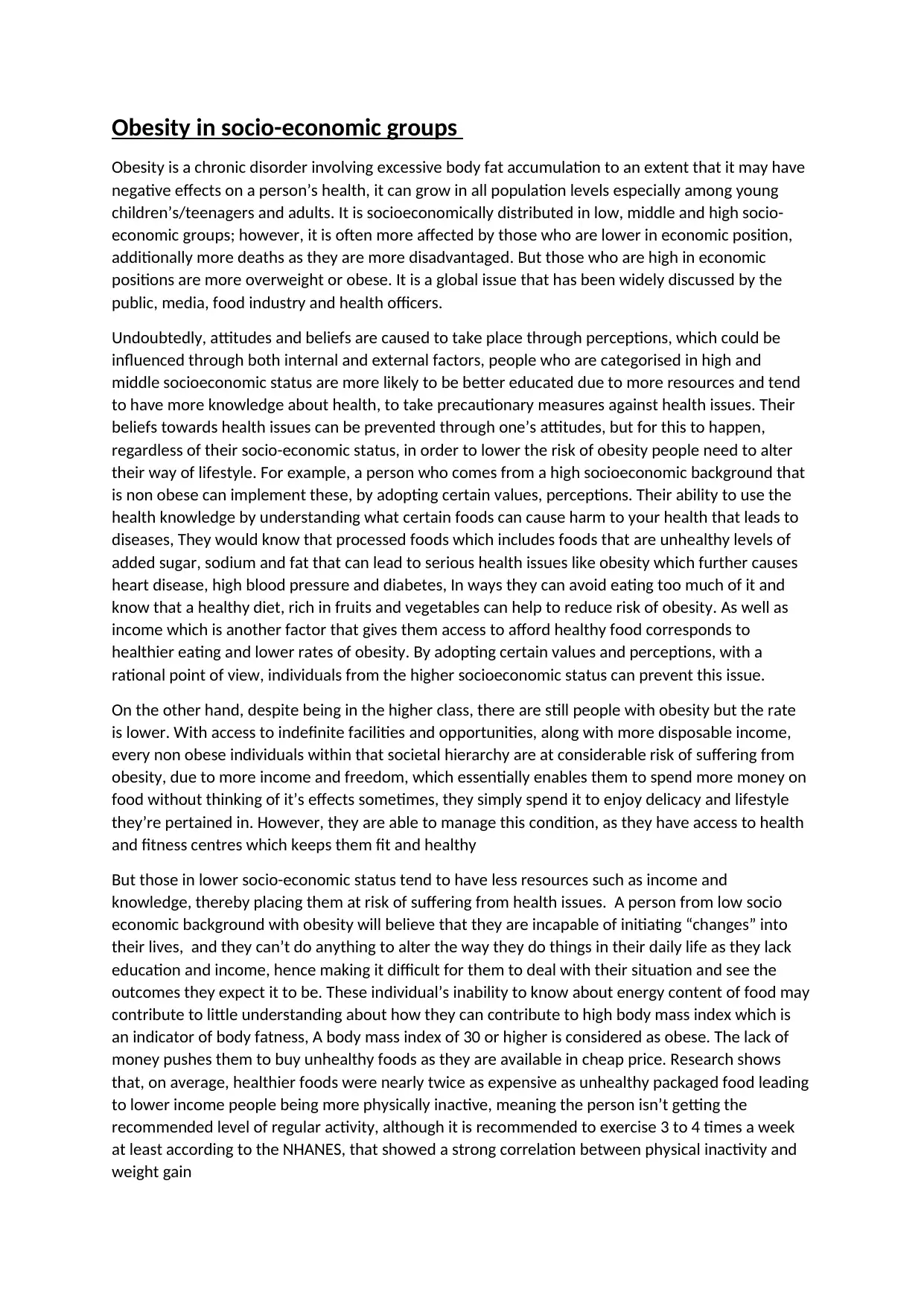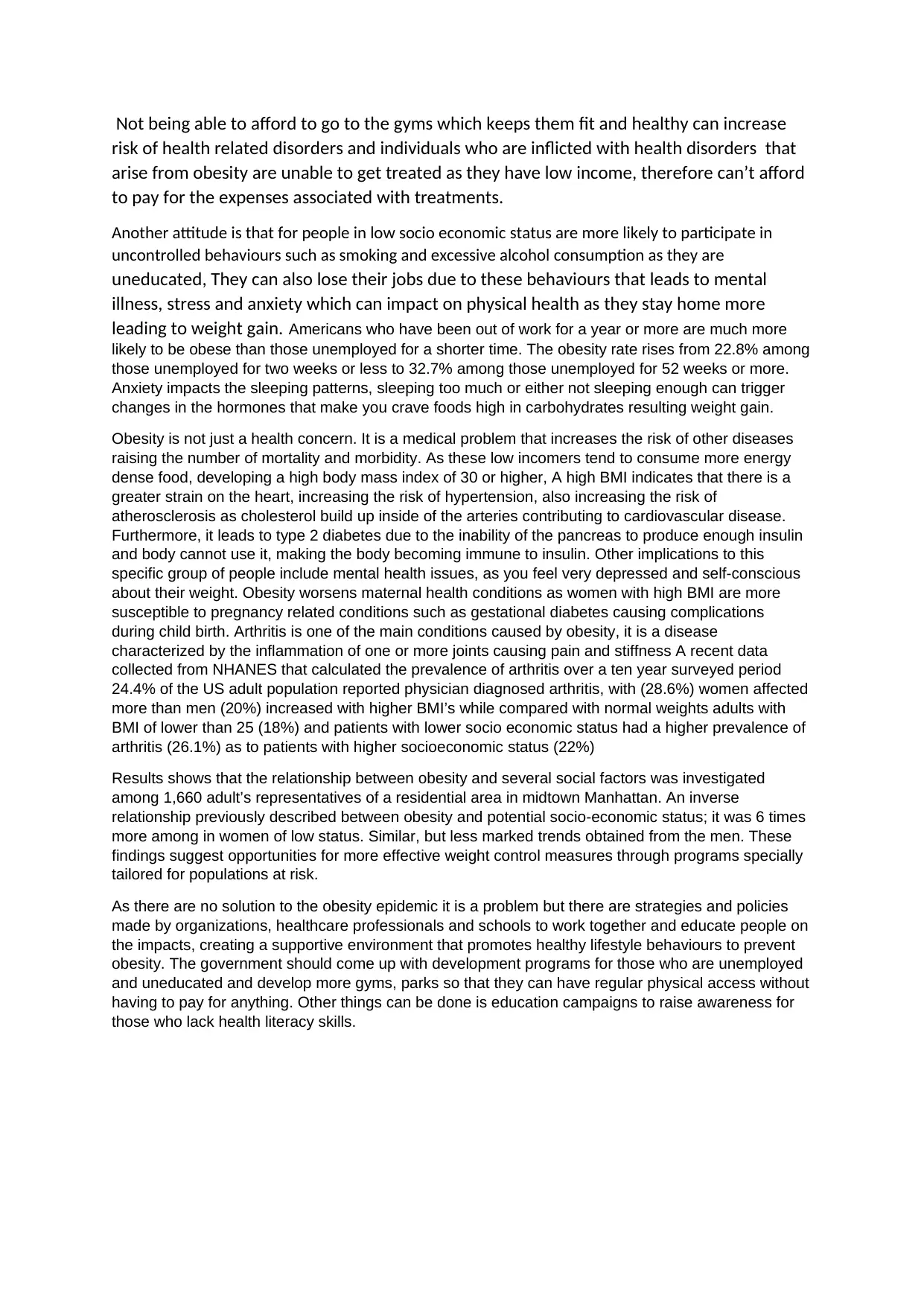An Examination of Obesity in Relation to Socioeconomic Groups
VerifiedAdded on 2021/08/16
|3
|1502
|65
Essay
AI Summary
This essay examines the complex relationship between obesity and socioeconomic status, highlighting how factors like income, education, and access to resources influence health outcomes. It discusses the varying impacts of obesity across low, middle, and high socioeconomic groups, emphasizing that those in lower economic positions often experience greater health disadvantages. The essay explores the role of attitudes, beliefs, and lifestyle choices in contributing to obesity, and it analyzes how disparities in access to healthy foods, healthcare, and fitness facilities affect different groups. It also addresses the impact of unemployment and mental health on obesity rates, along with the increased risk of related diseases like heart disease, diabetes, and arthritis. The essay concludes by suggesting potential strategies and policies, including government programs, educational campaigns, and the creation of accessible resources, to promote healthy lifestyle behaviors and prevent obesity across all socioeconomic levels.

Obesity in socio-economic groups
Obesity is a chronic disorder involving excessive body fat accumulation to an extent that it may have
negative effects on a person’s health, it can grow in all population levels especially among young
children’s/teenagers and adults. It is socioeconomically distributed in low, middle and high socio-
economic groups; however, it is often more affected by those who are lower in economic position,
additionally more deaths as they are more disadvantaged. But those who are high in economic
positions are more overweight or obese. It is a global issue that has been widely discussed by the
public, media, food industry and health officers.
Undoubtedly, attitudes and beliefs are caused to take place through perceptions, which could be
influenced through both internal and external factors, people who are categorised in high and
middle socioeconomic status are more likely to be better educated due to more resources and tend
to have more knowledge about health, to take precautionary measures against health issues. Their
beliefs towards health issues can be prevented through one’s attitudes, but for this to happen,
regardless of their socio-economic status, in order to lower the risk of obesity people need to alter
their way of lifestyle. For example, a person who comes from a high socioeconomic background that
is non obese can implement these, by adopting certain values, perceptions. Their ability to use the
health knowledge by understanding what certain foods can cause harm to your health that leads to
diseases, They would know that processed foods which includes foods that are unhealthy levels of
added sugar, sodium and fat that can lead to serious health issues like obesity which further causes
heart disease, high blood pressure and diabetes, In ways they can avoid eating too much of it and
know that a healthy diet, rich in fruits and vegetables can help to reduce risk of obesity. As well as
income which is another factor that gives them access to afford healthy food corresponds to
healthier eating and lower rates of obesity. By adopting certain values and perceptions, with a
rational point of view, individuals from the higher socioeconomic status can prevent this issue.
On the other hand, despite being in the higher class, there are still people with obesity but the rate
is lower. With access to indefinite facilities and opportunities, along with more disposable income,
every non obese individuals within that societal hierarchy are at considerable risk of suffering from
obesity, due to more income and freedom, which essentially enables them to spend more money on
food without thinking of it’s effects sometimes, they simply spend it to enjoy delicacy and lifestyle
they’re pertained in. However, they are able to manage this condition, as they have access to health
and fitness centres which keeps them fit and healthy
But those in lower socio-economic status tend to have less resources such as income and
knowledge, thereby placing them at risk of suffering from health issues. A person from low socio
economic background with obesity will believe that they are incapable of initiating “changes” into
their lives, and they can’t do anything to alter the way they do things in their daily life as they lack
education and income, hence making it difficult for them to deal with their situation and see the
outcomes they expect it to be. These individual’s inability to know about energy content of food may
contribute to little understanding about how they can contribute to high body mass index which is
an indicator of body fatness, A body mass index of 30 or higher is considered as obese. The lack of
money pushes them to buy unhealthy foods as they are available in cheap price. Research shows
that, on average, healthier foods were nearly twice as expensive as unhealthy packaged food leading
to lower income people being more physically inactive, meaning the person isn’t getting the
recommended level of regular activity, although it is recommended to exercise 3 to 4 times a week
at least according to the NHANES, that showed a strong correlation between physical inactivity and
weight gain
Obesity is a chronic disorder involving excessive body fat accumulation to an extent that it may have
negative effects on a person’s health, it can grow in all population levels especially among young
children’s/teenagers and adults. It is socioeconomically distributed in low, middle and high socio-
economic groups; however, it is often more affected by those who are lower in economic position,
additionally more deaths as they are more disadvantaged. But those who are high in economic
positions are more overweight or obese. It is a global issue that has been widely discussed by the
public, media, food industry and health officers.
Undoubtedly, attitudes and beliefs are caused to take place through perceptions, which could be
influenced through both internal and external factors, people who are categorised in high and
middle socioeconomic status are more likely to be better educated due to more resources and tend
to have more knowledge about health, to take precautionary measures against health issues. Their
beliefs towards health issues can be prevented through one’s attitudes, but for this to happen,
regardless of their socio-economic status, in order to lower the risk of obesity people need to alter
their way of lifestyle. For example, a person who comes from a high socioeconomic background that
is non obese can implement these, by adopting certain values, perceptions. Their ability to use the
health knowledge by understanding what certain foods can cause harm to your health that leads to
diseases, They would know that processed foods which includes foods that are unhealthy levels of
added sugar, sodium and fat that can lead to serious health issues like obesity which further causes
heart disease, high blood pressure and diabetes, In ways they can avoid eating too much of it and
know that a healthy diet, rich in fruits and vegetables can help to reduce risk of obesity. As well as
income which is another factor that gives them access to afford healthy food corresponds to
healthier eating and lower rates of obesity. By adopting certain values and perceptions, with a
rational point of view, individuals from the higher socioeconomic status can prevent this issue.
On the other hand, despite being in the higher class, there are still people with obesity but the rate
is lower. With access to indefinite facilities and opportunities, along with more disposable income,
every non obese individuals within that societal hierarchy are at considerable risk of suffering from
obesity, due to more income and freedom, which essentially enables them to spend more money on
food without thinking of it’s effects sometimes, they simply spend it to enjoy delicacy and lifestyle
they’re pertained in. However, they are able to manage this condition, as they have access to health
and fitness centres which keeps them fit and healthy
But those in lower socio-economic status tend to have less resources such as income and
knowledge, thereby placing them at risk of suffering from health issues. A person from low socio
economic background with obesity will believe that they are incapable of initiating “changes” into
their lives, and they can’t do anything to alter the way they do things in their daily life as they lack
education and income, hence making it difficult for them to deal with their situation and see the
outcomes they expect it to be. These individual’s inability to know about energy content of food may
contribute to little understanding about how they can contribute to high body mass index which is
an indicator of body fatness, A body mass index of 30 or higher is considered as obese. The lack of
money pushes them to buy unhealthy foods as they are available in cheap price. Research shows
that, on average, healthier foods were nearly twice as expensive as unhealthy packaged food leading
to lower income people being more physically inactive, meaning the person isn’t getting the
recommended level of regular activity, although it is recommended to exercise 3 to 4 times a week
at least according to the NHANES, that showed a strong correlation between physical inactivity and
weight gain
Paraphrase This Document
Need a fresh take? Get an instant paraphrase of this document with our AI Paraphraser

Not being able to afford to go to the gyms which keeps them fit and healthy can increase
risk of health related disorders and individuals who are inflicted with health disorders that
arise from obesity are unable to get treated as they have low income, therefore can’t afford
to pay for the expenses associated with treatments.
Another attitude is that for people in low socio economic status are more likely to participate in
uncontrolled behaviours such as smoking and excessive alcohol consumption as they are
uneducated, They can also lose their jobs due to these behaviours that leads to mental
illness, stress and anxiety which can impact on physical health as they stay home more
leading to weight gain. Americans who have been out of work for a year or more are much more
likely to be obese than those unemployed for a shorter time. The obesity rate rises from 22.8% among
those unemployed for two weeks or less to 32.7% among those unemployed for 52 weeks or more.
Anxiety impacts the sleeping patterns, sleeping too much or either not sleeping enough can trigger
changes in the hormones that make you crave foods high in carbohydrates resulting weight gain.
Obesity is not just a health concern. It is a medical problem that increases the risk of other diseases
raising the number of mortality and morbidity. As these low incomers tend to consume more energy
dense food, developing a high body mass index of 30 or higher, A high BMI indicates that there is a
greater strain on the heart, increasing the risk of hypertension, also increasing the risk of
atherosclerosis as cholesterol build up inside of the arteries contributing to cardiovascular disease.
Furthermore, it leads to type 2 diabetes due to the inability of the pancreas to produce enough insulin
and body cannot use it, making the body becoming immune to insulin. Other implications to this
specific group of people include mental health issues, as you feel very depressed and self-conscious
about their weight. Obesity worsens maternal health conditions as women with high BMI are more
susceptible to pregnancy related conditions such as gestational diabetes causing complications
during child birth. Arthritis is one of the main conditions caused by obesity, it is a disease
characterized by the inflammation of one or more joints causing pain and stiffness A recent data
collected from NHANES that calculated the prevalence of arthritis over a ten year surveyed period
24.4% of the US adult population reported physician diagnosed arthritis, with (28.6%) women affected
more than men (20%) increased with higher BMI’s while compared with normal weights adults with
BMI of lower than 25 (18%) and patients with lower socio economic status had a higher prevalence of
arthritis (26.1%) as to patients with higher socioeconomic status (22%)
Results shows that the relationship between obesity and several social factors was investigated
among 1,660 adult’s representatives of a residential area in midtown Manhattan. An inverse
relationship previously described between obesity and potential socio-economic status; it was 6 times
more among in women of low status. Similar, but less marked trends obtained from the men. These
findings suggest opportunities for more effective weight control measures through programs specially
tailored for populations at risk.
As there are no solution to the obesity epidemic it is a problem but there are strategies and policies
made by organizations, healthcare professionals and schools to work together and educate people on
the impacts, creating a supportive environment that promotes healthy lifestyle behaviours to prevent
obesity. The government should come up with development programs for those who are unemployed
and uneducated and develop more gyms, parks so that they can have regular physical access without
having to pay for anything. Other things can be done is education campaigns to raise awareness for
those who lack health literacy skills.
risk of health related disorders and individuals who are inflicted with health disorders that
arise from obesity are unable to get treated as they have low income, therefore can’t afford
to pay for the expenses associated with treatments.
Another attitude is that for people in low socio economic status are more likely to participate in
uncontrolled behaviours such as smoking and excessive alcohol consumption as they are
uneducated, They can also lose their jobs due to these behaviours that leads to mental
illness, stress and anxiety which can impact on physical health as they stay home more
leading to weight gain. Americans who have been out of work for a year or more are much more
likely to be obese than those unemployed for a shorter time. The obesity rate rises from 22.8% among
those unemployed for two weeks or less to 32.7% among those unemployed for 52 weeks or more.
Anxiety impacts the sleeping patterns, sleeping too much or either not sleeping enough can trigger
changes in the hormones that make you crave foods high in carbohydrates resulting weight gain.
Obesity is not just a health concern. It is a medical problem that increases the risk of other diseases
raising the number of mortality and morbidity. As these low incomers tend to consume more energy
dense food, developing a high body mass index of 30 or higher, A high BMI indicates that there is a
greater strain on the heart, increasing the risk of hypertension, also increasing the risk of
atherosclerosis as cholesterol build up inside of the arteries contributing to cardiovascular disease.
Furthermore, it leads to type 2 diabetes due to the inability of the pancreas to produce enough insulin
and body cannot use it, making the body becoming immune to insulin. Other implications to this
specific group of people include mental health issues, as you feel very depressed and self-conscious
about their weight. Obesity worsens maternal health conditions as women with high BMI are more
susceptible to pregnancy related conditions such as gestational diabetes causing complications
during child birth. Arthritis is one of the main conditions caused by obesity, it is a disease
characterized by the inflammation of one or more joints causing pain and stiffness A recent data
collected from NHANES that calculated the prevalence of arthritis over a ten year surveyed period
24.4% of the US adult population reported physician diagnosed arthritis, with (28.6%) women affected
more than men (20%) increased with higher BMI’s while compared with normal weights adults with
BMI of lower than 25 (18%) and patients with lower socio economic status had a higher prevalence of
arthritis (26.1%) as to patients with higher socioeconomic status (22%)
Results shows that the relationship between obesity and several social factors was investigated
among 1,660 adult’s representatives of a residential area in midtown Manhattan. An inverse
relationship previously described between obesity and potential socio-economic status; it was 6 times
more among in women of low status. Similar, but less marked trends obtained from the men. These
findings suggest opportunities for more effective weight control measures through programs specially
tailored for populations at risk.
As there are no solution to the obesity epidemic it is a problem but there are strategies and policies
made by organizations, healthcare professionals and schools to work together and educate people on
the impacts, creating a supportive environment that promotes healthy lifestyle behaviours to prevent
obesity. The government should come up with development programs for those who are unemployed
and uneducated and develop more gyms, parks so that they can have regular physical access without
having to pay for anything. Other things can be done is education campaigns to raise awareness for
those who lack health literacy skills.

REFRENCES:
https://jamanetwork.com/journals/jama/article-abstract/655863
Gallup, I. (2020). Obesity Linked to Long-Term Unemployment in U.S. Retrieved 24 April 2020, from
https://news.gallup.com/poll/171683/obesity-linked-long-term-unemployment.aspx
Gallup, I. (2020). Obesity Linked to Long-Term Unemployment in U.S. Retrieved 24 April 2020, from
https://news.gallup.com/poll/171683/obesity-linked-long-term-unemployment.aspx
https://jamanetwork.com/journals/jama/article-abstract/655863
Gallup, I. (2020). Obesity Linked to Long-Term Unemployment in U.S. Retrieved 24 April 2020, from
https://news.gallup.com/poll/171683/obesity-linked-long-term-unemployment.aspx
Gallup, I. (2020). Obesity Linked to Long-Term Unemployment in U.S. Retrieved 24 April 2020, from
https://news.gallup.com/poll/171683/obesity-linked-long-term-unemployment.aspx
⊘ This is a preview!⊘
Do you want full access?
Subscribe today to unlock all pages.

Trusted by 1+ million students worldwide
1 out of 3
Related Documents
Your All-in-One AI-Powered Toolkit for Academic Success.
+13062052269
info@desklib.com
Available 24*7 on WhatsApp / Email
![[object Object]](/_next/static/media/star-bottom.7253800d.svg)
Unlock your academic potential
Copyright © 2020–2025 A2Z Services. All Rights Reserved. Developed and managed by ZUCOL.





